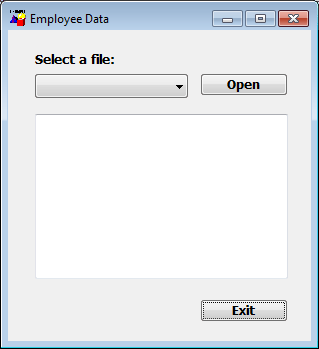Assume your application needs two windows with similar definitions. One window, w_employee, needs:
-
A title (Employee Data)
-
Text that says Select a file:
-
A drop-down list with a list of available employee files
-
An Open button with a script that opens the selected file in a multiline edit box
-
An Exit button with a script that asks the user to confirm closing the window and then closes the window
The window looks like this:
The only differences in the second window, w_customer, are that the title is Customer Data, the drop-down list displays customer files instead of employee files, and there is a Delete button so the user can delete files.
Your choices
To build these windows, you have three choices:
-
Build two new windows from scratch as described in Building a new window.
-
Build one window from scratch and then modify it and save it under another name
-
Use inheritance to build two windows that inherit a definition from an ancestor window
To build the two windows using inheritance, follow these steps:
-
Create an ancestor window, w_ancestor, that contains the text, drop-down list, and the open and exit buttons, and save and close it.
Note
You cannot inherit a window from an existing window when the existing window is open, and you cannot open a window when its ancestor or descendant is open.
-
Select File>Inherit, select w_ancestor in the Inherit From dialog box, and click OK.
-
Add the Employee Data title, specify that the DropDownListBox control displays employee files, and save the window as w_employee.
-
Select File>Inherit, select w_ancestor in the Inherit From dialog box, and click OK.
-
Add the Customer Data title, specify that the DropDownListBox control displays customer files, add the Delete button, and save the window as w_customer.



